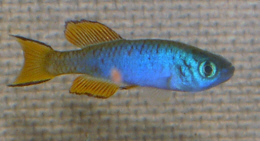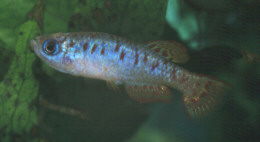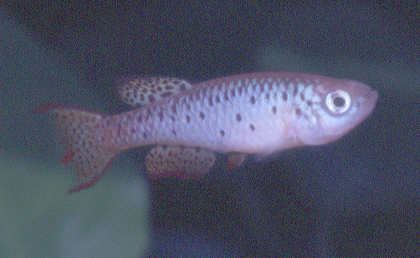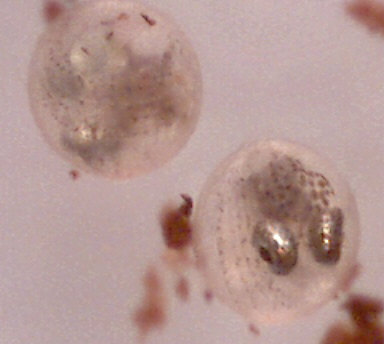Fundulosoma thierryi Ahl 1924
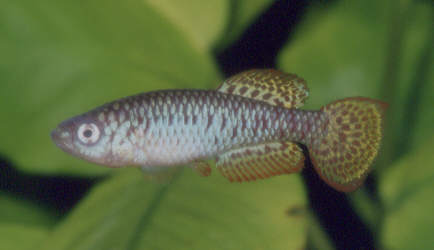
F.thierryi Mali. Photo courtesy of Ed Pürzl.
| Meaning of Name |
After Thierry |
|||||||
| First Description |
Fundulosoma thierryi Ahl 1924 |
|||||||
| Size |
|
|||||||
| Meristics |
|
|||||||
| Karyotype |
|
|||||||
| Sub-Genus |
|
|||||||
| Group |
|
|||||||
| Synonyms |
|
|||||||
Populations
|
GH 94 / 1 -
GHAAP 06 / 2, 5, 8 & 9 - Sometimes seen as GHN 06. Collected in Volta by David Armitage & Anthony Pinto, 2006.
K'palimé, Togo - 15 kms northwest of K'palimé. Collected by O.Gartner, O.Hofmann, 1985.
Mali - Collected in 1982 by a German guide whilst escorting a group of tourists in Mali. This population was reportedly prone to velvet & needed the addition of salt to the water. Milestone 56 - At the Collingham auction on September 10th 1972 a number of Scotsmen donated to the BKA a bucket containing 12 pairs collected at Milestone 56, Accra to Ade road, Accra Plain, southeast Ghana. Photographs of Kluge's strain & Clausen's Sogakofe collection can be found in ROTOW 1 pp 421-422. |
|||||||
| Type Locality |
Mangu District of northern Togo said to be located between Kadjamba & Bogo-Moba & Panpamba to Nacjaba in the north. |
|||||||
| Distribution |
|
|||||||
| Habitat |
Kluge's collection of 1959-60 gave the following data from a point between Takoradi & Alenda on the Tano River - water temperature 23-27°C, pH 5·7, German Hardness 1·5. |
|||||||
| Distinguishing Characteristics | A fairly small species with a large eye & narrow caudal peduncle. The caudal fin is of the flared type (similar to Fp.arnoldi). Easily seperated from Fp.arnoldi by unpaired fins which have a dark outer margin in thierryi. | |||||||
| Colour/Pattern Variability | Fairly low. | |||||||
| History |
Ahl described this sp. from 7 specimens (probably
males measuring 25-30 mm, according to Scheel) collected from the Mangu
District of northern Togo said to be located between Kadjamba &
Bogo-Moba in the south & Panpamba & Nacjaba in the north (ROTOW
1 p 421). Scheel considered this to be in an area of dry savannah
containing many temporary small river systems of the Kari-Oti-Volta
drainage of northern Togo. Known to have been in Holland in June 1960 (probably the first time in this country) when A.J.De.Looze received eggs from München, Germany. The June DATZ contained a small article on the sp. Foersch observed & photographed a fish Radda
referred to as 'Ghana Aphyosemion'
in 1961. These were later identified as Fp.walkeri
(or to be more accurate, Boulenger's Fundulus
walkeri of 1911). These are almost certainly referable
to 'thierryi'
in modern times. Pellegrin, in 1934, also examined 10 specimens
from Fada N'Gourma, Upper Volta, as Fundulus
walkeri. Eric Bowden wrote an article on the GH 1/94 population
in BKA newsletter No.374, November 1996. Fish bred at 8-10 mm in peat
which was collected weekly. Storage temperature was 30°C. He commented
that this species has a reputation for ceasing egg production after
10-12 weeks of age. Trying a 2nd wetting from stored peat does not seem
to produce any further fry. |
|||||||
| Breeding Notes |
DATZ in June 1961 contained a reference to keeping eggs in slightly damp peat environment for 2 months. Perhaps the first records of breeding this sp. (at least in the AKA) come from the Aquarium Journal of June 1961 where Rosario LaCorte bred them in a tank with a sand substrate. He recorded a 3 week incubation period in water. He noted that this sp. was slow to hatch, even for fully developed embryo's. He forced a hatch by adding microworm to the container. In an article by A.J.Delooze in the above publication
he mentioned a hatching where the fry were too small to take newly hatched
brine shrimp. He went by motorcycle to a pond where he collected a large
amount of infusoria which was taken by the fry. He had a large amount
of females but noticed a male after 6 weeks.
Embryo which hatched
out shortly after this photo was taken. A breeding report in BKA newsletter No. 224,
April 1984 concerning the Mali population stated that the pair were
given a 3 gallon tank. pH 7·5, DH 12, water temperature 80°F.
A half inch layer of peat was added to the tank base. I bred the GH 94/1 population in 2007 & found
fry numerous on hatching after 3 months incubation. At one point in
the incubation the peat dried out extensively & had to be moistened.
It was so dry I thought nothing could survive it. David Armitage in BKA newsletter No.503, August
2007 reports eggs from wild fish do not rest & 3 weeks is a maximum
they should be incubated or the fry will hatch emaciated or belly sliders.
Water used in wetting the eggs had peat extract added to make the pH
neutral (7). First males are seen to start colouring in 18-21 days &
can start spawning at 28. Pete Riley in BKA newsletter No.503, August 2007
reports breeding wild GHN (GHAAP) 06 / 2 population. Two trios were
set up in a 6 x 8 x 8" tank. Bare with a small sponge filter &
a 3" deep tray of fine peat. One of the males proved aggressive
to the other fish & was removed along with 2 of the larger females.
This male went on to kill both females. |
|||||||
| Diameter of Egg | 1
mm. Scheel in ROTOW 1 p 424 found the eggs to have a few long non adhesive filaments in one pole. They also differ from eggs of arnoldi & filamentosum by the absense of an hexagonal reticulated pattern on the membrane. |
|||||||
| Remarks |
In BKA newsletter No.79, March 1972 an article
appeared regarding social behaviour of this sp. (Ewing). The author
found males territorial although females were not. The size of their
territory was such that 15-20 males & 30-40 females could be safely
maintained in a 24 x 18 x 6" deep tank. This number should be maintained
& no attempt should be made to remove or add other fish. |
